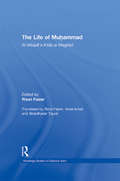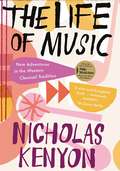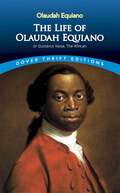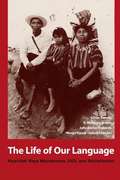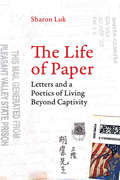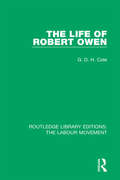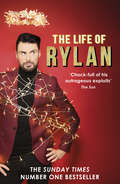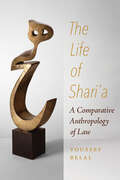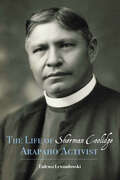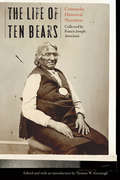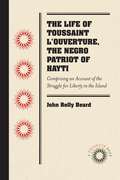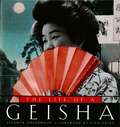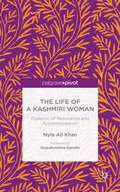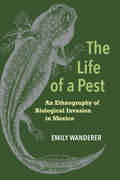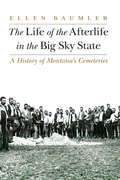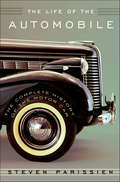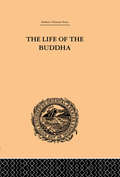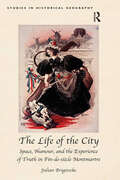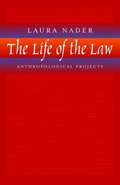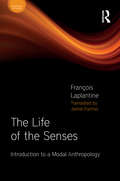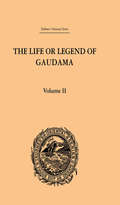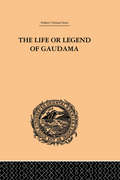- Table View
- List View
The Life of Muhammad: Al-Waqidi's Kitab al-Maghazi
by Rizwi FaizerMuhammad b. ‘Umar al-Waqidi was a Muslim scholar, born in Medina in the 1st Century. Of his several writings the most significant is the Kitab al-Maghazi, one of the earliest standard histories of the life of the Prophet. Translated into English for the first time, Rizwi Faizer makes available this key text to a new, English-speaking audience. It includes an "Introduction" authored jointly by Rizwi Faizer and Andrew Rippin and a carefully prepared index. The book deals with the events of the Prophet’s life from the time of his emigration from Mecca to his death, and is generally considered to be biographical. Bringing together events in the Prophet’s life with appropriate passages of Qur’an in a considered sequence, the author presents an interpretation of Islam that existed in his times. It includes citations from the Qur’ān, as well as poetry that appears to have been inspired by activities during his life. This English translation of a seminal text on the life of Muhammad is an invaluable addition to the existing literature, and will be of great significance to students and scholars in the field of Islamic studies, Islamic history, Medieval history and Arabic literature.
The Life of Music: New Adventures in the Western Classical Tradition
by Nicholas KenyonNicholas Kenyon explores the enduring appeal of the classical canon at a moment when we can access all music—across time and cultures&“At its lively best when Kenyon&’s own passions are laid bare, . . . his belief, above all, in the power of music to unite individual and community.&”—Fiona Maddocks, The Observer Immersed in music for much of his life as writer, broadcaster and concert presenter, former director of the BBC Proms, Nicholas Kenyon has long championed an astonishingly wide range of composers and performers. Now, as we think about culture in fresh ways, Kenyon revisits the stories that make up the classical tradition and foregrounds those which are too often overlooked. This inclusive, knowledgeable, and enthusiastic guide highlights the achievements of the women and men, amateurs and professionals, who bring music to life. Taking us from pianist Myra Hess&’s performance in London during the Blitz, to John Adams&’s composition of a piece for mourners after New York&’s 9/11 attacks, to Italian opera singers singing from their balconies amidst the 2020 pandemic, Kenyon shows that no matter how great the crisis, music has the power to bring us together. His personal, celebratory account transforms our understanding of how classical music is made—and shows us why it is more relevant than ever.
The Life of Olaudah Equiano: Large Print (Dover Thrift Editions Ser.)
by Olaudah EquianoCompelling work traces the formidable journey of an Igbo prince from captivity to freedom and literacy and recounts his enslavement in the New World, service in the Seven Years War with General Wolfe in Canada, voyages to the Arctic with the Phipps expedition of 1772-73, six months among the Miskito Indians in Central America, and a grand tour of the Mediterranean as a personal servant to an English gentlemen. Skillfully written, with a wealth of engrossing detail, this powerful narrative deftly illustrates the nature of the black experience in slavery.
The Life of Our Language: Kaqchikel Maya Maintenance, Shift, and Revitalization
by Susan Garzon R. Mckenna BrownThe native Maya peoples of Mexico, Guatemala, Honduras, and Belize have been remarkably successful in maintaining their cultural identity during centuries of contact with and domination by outside groups. <P><P>Yet change is occurring in all Mayan communities as contact with Spanish-speaking Ladino society increases. This book explores change and continuity in one of the most vital areas of Mayan culture--language use. <P> The authors look specifically at Kaqchikel, one of the most commonly spoken Mayan languages. Following an examination of language contact situations among indigenous groups in the Americas, the authors proceed to a historical overview of the use of Kaqchikel in the Guatemalan Highlands. They then present case studies of three highland communities in which the balance is shifting between Kaqchikel and Spanish. Wuqu' Ajpub', a native Kaqchikel speaker, gives a personal account of growing up negotiating between the two languages and the different world views they encode. The authors conclude with a look at the Mayan language revitalization movement and offer a scenario in which Kaqchikel and other Mayan languages can continue to thrive.
The Life of Paper: Letters and a Poetics of Living Beyond Captivity
by Sharon LukThe Life of Paper offers a wholly original and inspiring analysis of how people facing systematic social dismantling have engaged letter correspondence to remake themselves—from bodily integrity to subjectivity and collective and spiritual being. Exploring the evolution of racism and confinement in California history, this ambitious investigation disrupts common understandings of the early detention of Chinese migrants (1880s–1920s), the internment of Japanese Americans (1930s–1940s), and the mass incarceration of African Americans (1960s–present) in its meditation on modern development and imprisonment as a way of life. Situating letters within global capitalist movements, racial logics, and overlapping modes of social control, Sharon Luk demonstrates how correspondence becomes a poetic act of reinvention and a way to live for those who are incarcerated.
The Life of Robert Owen (Routledge Library Editions: The Labour Movement #11)
by G. D. ColeFirst published in 1925. Robert Owen was, in the author’s words, ‘that rarest of phenomena, an utterly disinterested critic of a system by which he had himself risen to greatness’, and in studying his life this work reveals with a remarkable clarity the first phases of the Industrial Revolution crowded as it was with events, changes, ideas, and characters. This title will be of great interest to scholars and students of labour history.
The Life of Rylan
by Rylan Clark-Neal*The Sunday Times Number One Bestseller*Well hark at you, stumbling upon my autobiography. Bet you wouldn't have put money on that three years ago, eh?! Please don't stress yourself out too much, though, it's actually socially acceptable nowadays that you're interested. Firstly I'd like to emphasise that I have WRITTEN THIS BOOK MYSELF, so be assured you're getting the TOOTH, the WHOLE TOOTH and NOTHING BUT THE TOOTH! (Which was my original choice of title, but babe, we're so over that.) This book documents my story, year by year, from my humble beginnings growing up in the East End of London, becoming one of the nation's most talked-about people overnight to finally moving up the spectrum from guilty pleasure, and getting nearer to national treasure.It will make you laugh, cry, and most importantly you'll discover who I really am. If it doesn't do any of those things you're not legally entitled to a refund - just clearing that up ;-).I hope you enjoy reading this book as much as I have enjoyed writing it. This book has been like therapy, and LORD was I in need. Enjoy!
The Life of Shari'a: A Comparative Anthropology of Law
by Youssef BelalIs there a way to think about contemporary life with knowledge that is neither modern nor Western? Rather than confining Islam to a "religion" and shariʿa to its "law," Youssef Belal provocatively argues that Islamic shariʿa is a mode of knowledge with its own concepts and scholarly categories through which the world and the self are grasped. The Life of Shariʿa considers two intertwined lineages: how Islamic scholars have formulated knowledge from the classical period to today and how Westerners have understood the law and its origins. By melding these two traditions, Belal puts the formation of modern law under a new light and offers, through a compelling conceptualization of shariʿa, a powerful argument for its continued relevance to the life of contemporary Muslims.
The Life of Sherman Coolidge, Arapaho Activist
by Dr. Tadeusz LewandowskiSherman Coolidge&’s (1860–1932) panoramic life as survivor of the Indian Wars, witness to the maladministration of the reservation system, mediator between Native and white worlds, and ultimate defender of Native rights and heritage made him the embodiment of his era in American Indian history. Born to a band of Northern Arapaho in present-day Wyoming, Des-che-wa-wah (Runs On Top) endured a series of harrowing tragedies against the brutal backdrop of the nineteenth-century Indian Wars. As a boy he experienced the merciless killings of his family in vicious raids and attacks, surviving only to be given up by his starving mother to U.S. officers stationed at a western military base. Des-che-wa-wah was eventually adopted by a sympathetic infantry lieutenant who changed his name and set his life on a radically different course. Over the next sixty years Coolidge inhabited western plains and eastern cities, rode in military campaigns against the Lakota, entered the Episcopal priesthood, labored as missionary to his tribe on the Wind River Reservation, fomented dangerous conspiracies, married a wealthy New York heiress, met with presidents and congressmen, and became one of the nation&’s most prominent Indigenous persons as leader of the Native-run reform group the Society of American Indians. Coolidge&’s fascinating biography is essential for understanding the myriad ways Native Americans faced modernity at the turn of the century.
The Life of Ten Bears: Comanche Historical Narratives
by Francis Joseph Attocknie Thomas W. KavanaghThe Life of Ten Bears is a remarkable collection of nineteenth-century Comanche oral histories given by Francis Joseph “Joe A” Attocknie. Although various elements of Ten Bears’s life (ca. 1790–1872) are widely known, including several versions of how the toddler Ten Bears survived the massacre of his family, other parts have not been as widely publicized, remaining instead in the collective memory of his descendants. Other narratives in this collection reference lesser-known family members. These narratives are about the historical episodes that Attocknie’s family thought were worth remembering and add a unique perspective on Comanche society and tradition as experienced through several generations of his family. Kavanagh’s introduction adds context to the personal narratives by discussing the process of transmission. These narratives serve multiple purposes for Comanche families and communities. Some autobiographical accounts, “recounting” brave deeds and war honors, function as validation of status claims, while others illustrate the giving of names; still others recall humorous situations, song-ridicules, slapstick, and tragedies. Such family oral histories quickly transcend specific people and events by restoring key voices to the larger historical narrative of the American West.
The Life of Toussaint L'Ouverture, the Negro Patriot of Hayti
by John Relly BeardToussaint L'Ouverture (1743-1803) won international renown in the Haitian fight for independence. He led thousands of former slaves into battle against French, Spanish, and English forces, routing the Europeans and seizing control of the entire island of Hispaniola. L'Ouverture became governor and commander-in-chief of Haiti before officially acknowledging French rule in 1801, when he submitted a newly written constitution to Napoleon Bonaparte (1769-1821) and the French legislature for ratification. In response, Bonaparte sent an army to depose L'Ouverture, who was taken prisoner in June of 1802 and shipped to France, where he died of pneumonia in April 1803. The Life of Toussaint L'Ouverture (1853) was first published in London on the fiftieth anniversary of L'Ouverture's death and remained the authoritative English-language history of L'Ouverture's life until the late twentieth century. Throughout the text, John Relly Beard compares L'Ouverture to famously successful white generals, argues for his supremacy, and states that his ultimate failure to liberate Haiti and untimely death are the products of unfortunate circumstances--not an indictment of his character or leadership abilities.A DOCSOUTH BOOK. This collaboration between UNC Press and the University of North Carolina at Chapel Hill Library brings selected classic works from the digital library of Documenting the American South back into print. DocSouth Books uses the latest digital technologies to make these works available as downloadable e-books or print-on-demand publications. DocSouth Books are unaltered from the original publication, providing affordable and easily accessible editions to a new generation of scholars, students, and general readers.
The Life of Trade: Events and Happenings in the Niumi’s Atlantic Center (Routledge Studies in Archaeology)
by Liza GijantoThe Life of Trade utilizes archaeological and historical sources to address the dynamic nature of the Atlantic trade on the Gambia River. Taking a fresh multi-disciplinary approach, the book highlights the region’s atypical position as a commercial crossroads and access point for both interior and Atlantic markets. This engagement with a diversified commodities trade brought about the formation of a multi-ethnic, multi-religious community which was supported by, and reliant on, economic exchange. Gijanto situates the Niumi Kingdom within the emerging capitalist world-system through the analysis of data collected from archaeological excavations at four sites: the central multi-ethnic trading village of Juffure, the associated British merchant company factory there, and the two nearby settlements of San Domingo and Lamin Conco. As part of the Atlantic world, residents were in a continual process of negotiation between their local socio-economic structures and the commodities and ideas introduced by foreign traders. Gijanto sheds light on these interactions, exploring the impact of increased access to wealth by examining a number of excavated objects associated with public display, including European glass trading beads, faunal and botanical remains and locally produced ceramics. Presenting new perspectives on the complex nature of the Atlantic trade in the region The Life of Trade enriches our understanding of this period of great change in West Africa.
The Life of a Geisha
by Liza Dalby Eleanor UnderwoodTHE LIFE OF A GEISHA illustrates the fascinating world of Japan's powerful and seductive geishas, a fading yet beautiful world that has captured the imaginations of millions of readers. This striking book contains full-color woodblock prints made during Japan's famous Edo Period, historic and contemporary photographs of geisha life, and images of the "floating world," Japan's mysterious artistic subculture. The accompanying text includes evocative Japanese poems and haikus. All celebrate the beauty and creativity of the geisha, who with her exquisitely detailed costume, elaborate makeup and hairstyle, and artfully ritualized behavior, chastely beguiles and entertains Japan's most powerful men.
The Life of a Geisha
by Liza Dalby Eleanor UnderwoodTHE LIFE OF A GEISHA illustrates the fascinating world of Japan's powerful and seductive geishas, a fading yet beautiful world that has captured the imaginations of millions of readers. This striking book contains full-color woodblock prints made during Japan's famous Edo Period, historic and contemporary photographs of geisha life, and images of the "floating world," Japan's mysterious artistic subculture. The accompanying text includes evocative Japanese poems and haikus. All celebrate the beauty and creativity of the geisha, who with her exquisitely detailed costume, elaborate makeup and hairstyle, and artfully ritualized behavior, chastely beguiles and entertains Japan's most powerful men.
The Life of a Kashmiri Woman: Dialectic of Resistance and Accommodation
by Nyla Ali KhanCapturing the history of Kashmir and its cultural and social evolution, Nyla Ali Kahn deconstructs the life of her grandmother and other women of her generation to reconceptualize woman's identity in a politically militarized zone. An academic memoir, this book succinctly brings together the history, politics, and culture of Kashmir.
The Life of a Pest: An Ethnography of Biological Invasion in Mexico
by Emily WandererThe Life of a Pest tracks the work practices of scientists in Mexico as they study flora and fauna at scales ranging from microscopic to ecosystemic. Amid concerns about climate change, infectious disease outbreaks, and biotechnology, scientists in Mexico have expanded the focus of biopolitics and biosecurity, looking beyond threats to human life to include threats to the animal, plant, and microbial worlds. Emily Wanderer outlines how concerns about biosecurity are leading scientists to identify populations and life-forms either as worthy of saving or as "pests" in need of elimination. Moving from high security labs where scientists study infectious diseases, to offices where ecologists regulate the use of genetically modified organisms, to remote islands where conservationists eradicate invasive species, Wanderer explores how scientific research informs, and is informed by, concepts of nation.
The Life of the Afterlife in the Big Sky State: A History of Montana's Cemeteries
by Ellen BaumlerThe Life of the Afterlife in the Big Sky State is a groundbreaking history of death in Montana. It offers a unique, reflective, and sensitive perspective on the evolution of customs and burial grounds. Beginning with Montana&’s first known burial site, Ellen Baumler considers the archaeological records of early interments in rock ledges, under cairns, in trees, and on open-air scaffolds. Contact with Europeans at trading posts and missions brought new burial practices. Later, crude &“boot hills&” and pioneer graveyards evolved into orderly cemeteries. Planned cemeteries became the hallmark of civilization and the measure of an educated community. Baumler explores this history, yet untold about Montana. She traces the pathway from primitive beginnings to park-like, architecturally planned burial grounds where people could recreate, educate their children, and honor the dead.The Life of the Afterlife in the Big Sky State is not a comprehensive listing of the many hundreds of cemeteries across Montana. Rather it discusses cultural identity evidenced through burial practices, changing methods of interments and why those came about, and the evolution of cemeteries as the &“last great necessity&” in organized communities. Through examples and anecdotes, the book examines how we remember those who have passed on.
The Life of the Automobile: The Complete History of the Motor Car
by Steven ParissienThe Life of the Automobile is the first comprehensive world history of the car.The automobile has arguably shaped the modern era more profoundly than any other human invention, and author Steven Parissien examines the impact, development, and significance of the automobile over its turbulent and colorful 130-year history. Readers learn the grand and turbulent history of the motor car, from its earliest appearance in the 1880s—as little more than a powered quadricycle—and the innovations of the early pioneer carmakers. The author examines the advances of the interwar era, the Golden Age of the 1950s, and the iconic years of the 1960s to the decades of doubt and uncertainty following the oil crisis of 1973, the global mergers of the 1990s, the bailouts of the early twenty-first century, and the emergence of the electric car.This is not just a story of horsepower and performance but a tale of extraordinary people: of intuitive carmakers such as Karl Benz, Sir Henry Royce, Giovanni Agnelli (Fiat), André Citroën, and Louis Renault; of exceptionally gifted designers such as the eccentric, Ohio-born Chris Bangle (BMW); and of visionary industrialists such as Henry Ford, Ferdinand Porsche (the Volkswagen Beetle), and Gene Bordinat (the Ford Mustang), among numerous other game changers.Above all, this comprehensive history demonstrates how the epic story of the car mirrors the history of the modern era, from the brave hopes and soaring ambitions of the early twentieth century to the cynicism and ecological concerns of a century later. Bringing to life the flamboyant entrepreneurs, shrewd businessmen, and gifted engineers that worked behind the scenes to bring us horsepower and performance, The Life of the Automobile is a globe-spanning account of the auto industry that is sure to rev the engines of entrepreneurs and gearheads alike.
The Life of the Buddha and the Early History of His Order: Derived From Tibetan Works In The Bkah-hgyur And Bstan-hgyur (classic Reprint)
by W. Woodhill RockhillFirst Published in 2000. Routledge is an imprint of Taylor & Francis, an informa company.
The Life of the City: Space, Humour, and the Experience of Truth in Fin-de-siècle Montmartre
by Julian BrigstockeCould the vitality of embodied experience create a foundation for a new form of revolutionary authority? The Life of the City is a bold and innovative reassessment of the early urban avant-garde movements that sought to re-imagine and reinvent the experiential life of the city. Constructing a ground-breaking theoretical analysis of the relationships between biological life, urban culture, and modern forms of biopolitical ’experiential authority’, Julian Brigstocke traces the failed attempts of Parisian radicals to turn the ’crisis of authority’ in late nineteenth-century Paris into an opportunity to invent new forms of urban commons. The most comprehensive account to date of the spatial politics of the literary, artistic and anarchist groups that settled in the Montmartre area of Paris after the suppression of the 1871 Paris Commune, The Life of the City analyses the reasons why laughter emerged as the unlikely tool through which Parisian bohemians attempted to forge a new, non-representational biopolitics of sensation. Ranging from the carnivalesque performances of artistic cabarets such as the Chat Noir to the laughing violence of anarchist terrorism, The Life of the City is a timely analysis of the birth of a carnivalesque politics that remains highly influential in contemporary urban movements.
The Life of the Law: Anthropological Projects
by Laura NaderIn this critical retrospective on the interactions between lawyers and anthropologists, Laura Nader seeks to redefine and reinvigorate the role of the plaintiff and of tort law in order to fight back against corporate hegemony and take back the law as a tool for seeking social justice.
The Life of the Longhouse: An Archaeology of Ethnicity
by Peter MetcalfFor two centuries, travellers were amazed at the massive buildings found along the rivers that flow from the mountainous interior of Borneo. They concentrated hundreds of people under one roof, in the middle of empty rainforests. There was no practical necessity for this arrangement, and it remains a mystery. Peter Metcalf provides an answer by showing the historical context, using both oral histories and colonial records. The key factor was a pre-modern trading system that funneled rare and exotic jungle products to China via the ancient coastal city of Brunei. Meanwhile the elite manufactured goods traded upriver shaped the political and religious institutions of longhouse society. However, the apparent permanence of longhouses was an illusion. In historical terms, longhouse communities were both mobile and labile, and the patterns of ethnicity they created more closely resemble the contemporary world than any stereotype of "tribal" societies.
The Life of the Senses: Introduction to a Modal Anthropology (Sensory Studies)
by François LaplantineBoth a vital theoretical work and a fine illustration of the principles and practice of sensory ethnography, this much anticipated translation is destined to figure as a major catalyst in the expanding field of sensory studies.Drawing on his own fieldwork in Brazil and Japan and a wide range of philosophical, literary and cinematic sources, the author outlines his vision for a ‘modal anthropology’. François Laplantine challenges the primacy accorded to ‘sign’ and ‘structure’ in conventional social science research, and redirects attention to the tonalities and rhythmic intensities of different ways of living. Arguing that meaning, sensation and sociality cannot be considered separately, he calls for a 'politics of the sensible' and a complete reorientation of our habitual ways of understanding reality.The book also features an introduction to the sensory and social thought of François Laplantine by the editor of the Sensory Studies series, David Howes.
The Life or Legend of Gaudama the Buddha of the Burmese: The Buddha Of The Burmese: Volume I
by P. BigandetThis is Volume V in a series of sixteen on Buddhism. Originally published in 1912, this study is the second part of a look at the life or legend of Gaudama, the Buddha of the Burmese, with annotations and the ways of the Neibban and notice on the Phogyies or Burmese Monks.
The Life or Legend of Gaudama: The Buddha of the Burmese: Volume I
by P. BigandetFirst published in 2000. Routledge is an imprint of Taylor & Francis, an informa company.
